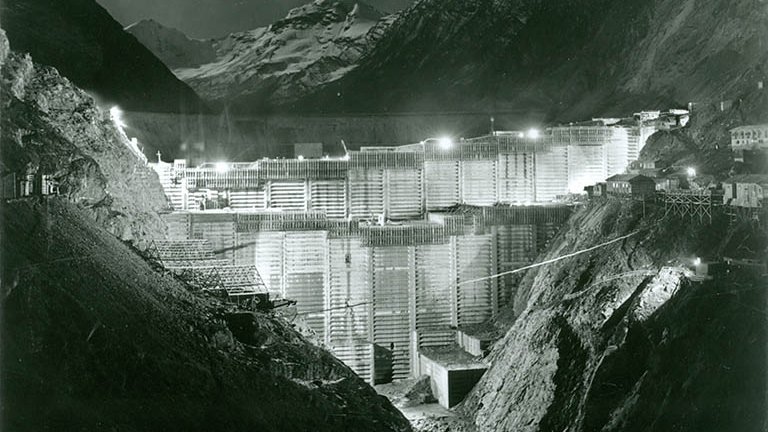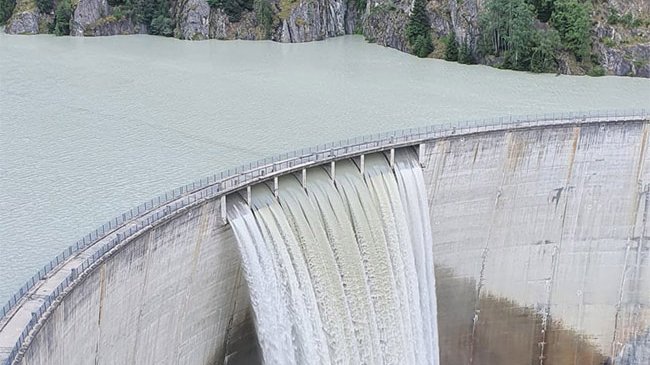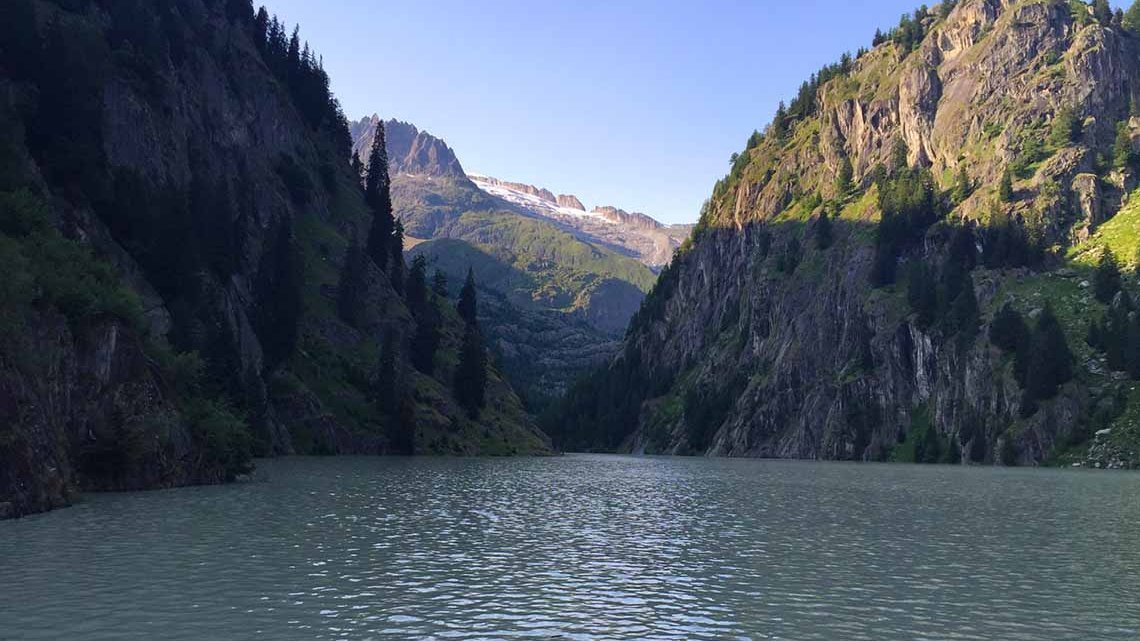In Switzerland, many large power plants are organised as so-called partner power plants. What exactly is this structure all about? In the following article we explain how partner power plants work and why they are needed.
In Switzerland, many larger power plants have a structure known as a “partner power plant”. Well-known examples include the large hydropower plants Grande Dixence in the Valais and the Kraftwerke Oberhasli in the Grimsel area, or the two large nuclear power plants in Gösgen and Leibstadt. Below, we explore why these partner plants exist, how they differ from one other, and why some have many employees while others have almost none.
Why do these partner power plants exist?
The large storage power plants are all located in mountainous areas because of the topography. When these power plants were planned and built, the mountain regions were economically weak and the demand for electricity there was still low at that time – in stark contrast to the cities and the Swiss Midlands, where the possibilities for generating hydropower on the Central Plateau alone were not sufficient to meet the already rapidly increasing demand for electricity. In the mountain regions, there was a lot of potential for the construction of dams and this is how the first Alpine partner plants came into being.
They were called partner plants because several investors participated in a joint stock company to spread the risk over several shoulders. Those with a need for electricity invested. These plants, developed with a great deal of pioneering spirit, even made it possible to produce an oversupply of electricity. The lack of customers was therefore a risk, and the partner plants model made it possible to spread this risk over several investors. It could be described as a joint venture with the legal form of a public limited company.
The basic characteristic of a partner plant is that the shareholders undertake to pay the operating costs on a pro rata basis and in return they receive the corresponding share of electricity at “cost plus” price, plus, due to tax reasons. This is usually done via a shareholders’ agreement. Since most of the shareholders are not located in the mountain regions, a large part of the value added (and the potential losses) does not occur at the location of the partner plants, but at the locations of the shareholder companies of the partner plants.

Why are partner plants still needed today?
For the same reason as before: to spread the risks. Once the partner plants are in operation, however, the risk today is no longer that the electricity might not be sold, but rather the risks associated with fluctuations in the electricity price, operational unavailability, stock market fluctuations related to the nuclear decommissioning and waste disposal fund, lower inflows, etc. This is because the operating costs, including the level of charges such as water rates (tax on the water used = “Wasserzins”), are fixed.
However, whether the operating costs of the partner plants can be covered depends very much on the selling price of the electricity, be it the retail price or the wholesale price. Before electricity prices rose sharply in 2022, they had been below production costs for almost a decade in Switzerland. For the reasons mentioned above, the losses were not incurred by the partner plants, but had to be covered by the shareholders, just as the profits are incurred by them today. This has led to large “impairments”, i.e. changes in the valuation of the power plants as assts.
Michael Wider, Alpiq's Head of Business Unit Switzerland, knows the world of partner plants like no other – in good times and in bad. He says: “Just like the projects we have today, these were huge, pioneering construction projects that often took over a decade to complete, with huge economic and technical risks and opportunities. Therefore, it was better to undertake them together rather than alone.”
Michael speaks from direct experience. Under his direction, Switzerland’s most recent partner plant, the Nant de Drance pumped storage power plant, was commissioned last year after 14 years of construction. During the construction period, electricity prices initially fell from their highest to their lowest level, only to climb from a long lean period to record new levels just at the time of commissioning. It was a true rollercoaster ride of emotions. For a pumped storage power plant, however, the level of the electricity price alone is not relevant. Rather, the difference between the price of the energy for pumping and the energy produced must be sufficiently large for a pumped storage plant to operate profitably.

How do partner plants actually work?
The partner plants primarily produce electricity and are responsible for its smooth operation, while the costs of operation are distributed proportionately among the shareholders. In return, the shareholders receive the electricity produced. Each participating company can then sell it on itself either to their direct customers or via electricity trading on the market, depending on the company’s structure. The investments in the plants are decided by the governing bodies of the partner plant companies and in most cases are also financed by the partner plants themselves.
Nevertheless, the partner plants differ in many respects. Energy management, investment policy, types of financing need to be optimally adapted to the characteristics of each plant. Three examples of power plant structures are given below:
- In a nuclear power partner plant, such as Gösgen, shareholders purchase a proportion of the energy produced by the power station at cost price. With a 40% stake in the Gösgen nuclear power station, Alpiq purchases 40% of the energy produced each year. With an average annual production of 8,000 GWh, this corresponds to 3,200 GWh.
- In a storage power plant, such as Grande Dixence, the reservoir volume is distributed proportionally. The share of the participation corresponds to a “virtual” water volume. For example, Alpiq has a 60% share in Grand Dixence, which means it can use 60% of the water stored. The remaining water is divided among the other three shareholders, with each shareholder deciding when and how he wants to produce his water volume in accordance with its shareholding.
- In a power plant with a small reservoir but a lot of water, such as Electra-Massa at the foot of the Great Aletsch Glacier, the distribution of the water is also based on the shareholding. However, the values of the water are defined on the basis of different production profiles, because the reservoir is not large enough for all the water to be turbined only at peak times. Especially in the summer months, the power plant runs at full load practically around the clock so that as much water as possible can be used and does not flow unused over the dam wall. It is clear that peak energy does not have the same value as band energy and thus a smaller amount of water is allocated for peak energy.
As a rule, the main responsibility for energy management is assigned to the shareholder with the largest stake in the company. These shareholders, such as Alpiq, are also the companies that have the competencies and systems to use the energy as optimally and profitably as possible.
The large plants in the Alps, such as Grande Dixence or Nant de Drance, are characterised by their performance and flexibility. These plants were built as systemic ones that benefit the stability of the Swiss high-voltage grid and contribute to security of supply. Their energy is not intended for the basic supply, but among other things creates the grid conditions to ensure it.

Who operates the partner plants?
Plants like the Leibstadt and Gösgen nuclear power plants employ many of their own staff, who ensure the operation of the plant. This makes sense for highly specialised plants such as nuclear power plants.
In Valais and Vaud, numerous partner plants are managed by an operating company, Hydro Exploitation, which is responsible for the operation and maintenance of these plants. These include Grande Dixence, Electra-Massa, Forces Motrices Hongrin-Léman and Forces Motrices de la Gougra. Hydro Exploitation specialises in the operation of hydroelectric power plants and has an extremely high level of technical and professional competence. The focus here is on professionalism in operation and maintenance, because if a power plant fails for even a few days, this can lead to a major economic loss for the partners.
Various partner plants, such as Grande Dixence and energy suppliers like Alpiq, have a stake in Hydro Exploitation. Management of the asset, above all the strategic aspects of the partner plant, is carried out by the partners and shareholders of this plant.
Is it possible to finance partner plants via the capital market?
Power plants such as hydropower or nuclear power plants are very capital-intensive. The concessions for hydropower plants usually run for 80 years. This means that investments in the plants will maintain their substance over at least 80 years. This expenditure needs to be financed. As a rule, the partner plants are usually financed through bonds, and in the case of majority holdings and consolidation by one shareholder, also through so-called intercompany financing.
Should the community exercise reversion at the end of the concession (the so-called “Heimfall”) and take over the facility, the facility must be depreciated, and the debts repaid. The amortisation and capital costs are part of the annual operating costs that must be generated. Even after the reversion and/or the possible change of the “Wasserrechtsberechtigten” – that is, the concessionaire who receives the right to use the water – the plant retains its energy and operational value with a new initial balance.
So far it has been shown that the capital markets are interested in hydropower plants. This is undoubtedly related to the fact that the partners and shareholders of the partner plants are often directly or indirectly in public hands. But, more importantly, it is also related to the fact that hydropower is a clean energy source and thus also gives the financial market access to green investments, which are in high demand. This is shown by the recent example of Nant de Drance (see above in the text).
What is the biggest advantage/disadvantage of partner plants?
The biggest advantage is that the risks are spread over several partners – but that’s also a disadvantage. Why? It is more difficult to reach decisions when many partners are involved than when one company alone is responsible. On the other hand, it also encourages us to look for viable solutions and to find majorities. “The partner plants are typical for Switzerland,” says Michael Wider. “We are dependent on each other, and we have to be able to rely on one other. As a country and as companies, we are too small to go it alone with large projects. In return, we receive stability and a long-term perspective.”
The situation becomes more challenging when the various partners have different interests, a change is pending as a result of democratic processes, or one party runs into economic difficulties. Particularly in the context of business continuity management, the three energy companies that ElCom defines as systemically important – Alpiq, Axpo and BKW – work to ensure that operations can be maintained in the event of the failure of one party in a partner plant. A project has been underway since last year to take this into account.
